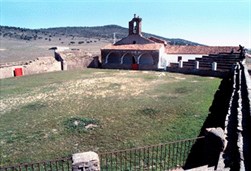Plazas and Ermitas: La Parra and Almagro
 Even the square of La Parra (Badajoz) is considered one of the oldest in Spain. It is united to the ermita (shrine) of San Juan (Saint John), the protector of the town, and the two buildings were built at the same time. The complex is located on the outskirts of La Parra, in the countryside and has, in addition to the plaza, a chapel, a refectory, an old hospedería (hostel) and other installations. In principle, the fence probably also served as a shelter for cattle that moved down into the valley, along the way of the cañada realThe Cañadas Reales, were the ways of transit of flocks, which existed throughout Spain during the Early Modern period.. The structure was built in the sixteenth century under the orders of Don Lorenzo Suárez de Figueroa, Master of the Order of Santiago and father of the first Duke of Feria. The emblem of the powerful Dukes of Feria still exists on the façade of the ermita.
Even the square of La Parra (Badajoz) is considered one of the oldest in Spain. It is united to the ermita (shrine) of San Juan (Saint John), the protector of the town, and the two buildings were built at the same time. The complex is located on the outskirts of La Parra, in the countryside and has, in addition to the plaza, a chapel, a refectory, an old hospedería (hostel) and other installations. In principle, the fence probably also served as a shelter for cattle that moved down into the valley, along the way of the cañada realThe Cañadas Reales, were the ways of transit of flocks, which existed throughout Spain during the Early Modern period.. The structure was built in the sixteenth century under the orders of Don Lorenzo Suárez de Figueroa, Master of the Order of Santiago and father of the first Duke of Feria. The emblem of the powerful Dukes of Feria still exists on the façade of the ermita.
 Almagro’s plaza is irregular and is in fact one of the oldest in Spain. It is joined to the shrine of the Virgen de las Nives, a monastery dating back to the twelfth century that was completely rebuilt between 1637 and 1641 at the behest of the Marquis of Santa Cruz Álvaro de Bazán y Guzmán as a votive offering for having returned unharmed from the Battle of LepantoWas a naval battle that took place on 7 October 1571 and that pitted the Holy League (Spanish Monarchy, the Duchy of Savoy, the Papacy and the Republics of Venice and Genoa) against the Ottoman Empire. The victory put a stop to the Ottoman expansion towards the Christian West.. Probably the position of the monastery, along an important way that once united Portugal and Extremadura with the regions of the Levant, meant that the site was well known and in the seventeenth century and it had a tavern which is still in operation. The first nucleus of the plaza dates back to the works carried out by Bazán family in 1641, and just over a century later, between 1761 and 1771, the Brotherhood de las Nives and private individuals financed its modernization and the fence. The brotherhood was responsible for the organization of the bullfightings which were celebrated in honour of the Virgin on 5 August. The monastery was severely damaged during the Civil War and was rebuilt in 1948. The window that allows the statue of the Virgin to face the ring and to preside over the bullfighting and protect the contenders stands out. It can hold about 2,000 people, and is currently used for minor spectacles. In addition to the monastery and the plaza, the complex has the aforementioned restaurant, a space once used for theatrical performances and which was the country residence of the Bazán family.
Almagro’s plaza is irregular and is in fact one of the oldest in Spain. It is joined to the shrine of the Virgen de las Nives, a monastery dating back to the twelfth century that was completely rebuilt between 1637 and 1641 at the behest of the Marquis of Santa Cruz Álvaro de Bazán y Guzmán as a votive offering for having returned unharmed from the Battle of LepantoWas a naval battle that took place on 7 October 1571 and that pitted the Holy League (Spanish Monarchy, the Duchy of Savoy, the Papacy and the Republics of Venice and Genoa) against the Ottoman Empire. The victory put a stop to the Ottoman expansion towards the Christian West.. Probably the position of the monastery, along an important way that once united Portugal and Extremadura with the regions of the Levant, meant that the site was well known and in the seventeenth century and it had a tavern which is still in operation. The first nucleus of the plaza dates back to the works carried out by Bazán family in 1641, and just over a century later, between 1761 and 1771, the Brotherhood de las Nives and private individuals financed its modernization and the fence. The brotherhood was responsible for the organization of the bullfightings which were celebrated in honour of the Virgin on 5 August. The monastery was severely damaged during the Civil War and was rebuilt in 1948. The window that allows the statue of the Virgin to face the ring and to preside over the bullfighting and protect the contenders stands out. It can hold about 2,000 people, and is currently used for minor spectacles. In addition to the monastery and the plaza, the complex has the aforementioned restaurant, a space once used for theatrical performances and which was the country residence of the Bazán family.
